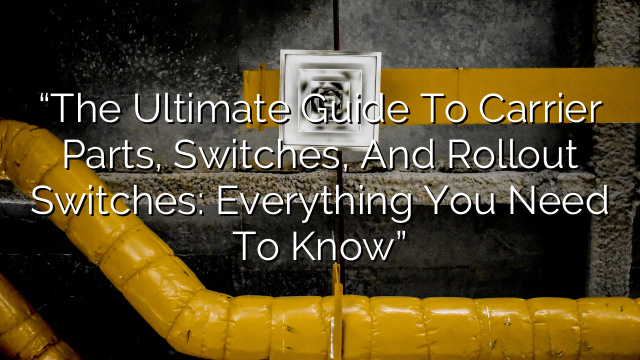Introduction
Welcome to our ultimate guide to Carrier parts, switches, and rollout switches. In this comprehensive guide, we will provide you with everything you need to know about Carrier parts and switches, including their functions, types, and how to choose the right ones for your Carrier system. So whether you are a homeowner or a technician, this guide will be your go-to resource for all things related to Carrier parts and switches.
What are Carrier Parts?
Carrier parts are components that make up a Carrier HVAC system. These parts are essential for the proper functioning of the system and include a wide range of items, such as motors, capacitors, contactors, filters, and more. Each part plays a specific role in the system and contributes to its overall efficiency and performance.
Types of Carrier Parts
Carrier parts come in various types and sizes, depending on the specific application and system model. Here are some common types of Carrier parts:
- Blower Motors: Blower motors are responsible for circulating air throughout the system. They come in different capacities and speeds to meet the airflow requirements of different systems.
- Capacitors: Capacitors store electrical energy and release it when needed. They play a crucial role in starting and running motors in Carrier systems.
- Contactors: Contactors are electrical switches that control the flow of electricity to various components in the system, such as the compressor and fan motors.
- Filters: Filters remove dust, allergens, and other impurities from the air before it is circulated throughout the system. Carrier offers a wide range of filters, including standard, high-efficiency, and specialty filters.
- Thermostats: Thermostats regulate the temperature in a Carrier system by controlling when the system turns on and off. They can be programmed to maintain a specific temperature or adjust the temperature based on occupancy patterns.
Carrier Switches
Carrier switches are electrical devices that control the operation of various components in the HVAC system. They are designed to open or close the electrical circuit based on specific conditions or inputs. Here are some common types of Carrier switches:
- Pressure Switches: Pressure switches monitor the pressure of refrigerant in the system and ensure that it is within safe limits. They can shut down the system if the pressure exceeds or falls below the set limits.
- Limit Switches: Limit switches are safety devices that protect the system from overheating. They monitor the temperature of critical components, such as the heat exchanger, and shut down the system if it exceeds the safe operating temperature.
- Defrost Control Switches: Defrost control switches are used in heat pump systems to activate the defrost cycle when the outdoor unit accumulates frost or ice. They prevent ice buildup and ensure proper heating operation.
- Flow Switches: Flow switches detect the flow of water or refrigerant in the system and provide a signal to control other components, such as pumps or valves. They are commonly used in hydronic and chilled water systems.
Carrier Rollout Switches
Carrier rollout switches are safety devices that protect the system from the risk of a fire or high-temperature conditions. They are typically installed in the burner assembly of furnaces and detect abnormal flame conditions or excessive temperatures. If a rollout switch senses an unsafe condition, it will interrupt the flow of gas and shut down the furnace to prevent any potential hazards.
How to Choose the Right Carrier Parts and Switches
Choosing the right Carrier parts and switches is essential for optimal system performance and longevity. Here are some factors to consider when selecting these components:
- Compatibility: Ensure that the parts and switches you choose are compatible with your specific Carrier system model. Consult the system’s manual or contact a Carrier dealer for assistance.
- Quality: Invest in high-quality parts and switches to ensure reliability and durability. Carrier is known for manufacturing top-quality components that meet stringent industry standards.
- Efficiency: Consider choosing energy-efficient components to maximize the efficiency of your Carrier system. Look for energy-saving labels or consult an HVAC technician for recommendations.
- Warranty: Check the warranty offered by the manufacturer. A longer warranty period indicates the manufacturer’s confidence in the product’s quality and performance.
- Installation: While some parts and switches can be easily replaced by homeowners, others may require professional installation. Consult an HVAC technician for complex installations.
FAQs
Q: Can I replace Carrier parts and switches myself?
A: Some Carrier parts and switches can be replaced by homeowners with basic DIY skills. However, it is recommended to consult an HVAC technician for complex installations or if you are unsure about the procedure.
Q: Where can I buy Carrier parts and switches?
A: Carrier parts and switches can be purchased from authorized Carrier dealers or HVAC supply stores. You can also find them online from reputable retailers.
Q: How often should Carrier parts be replaced?
A: The lifespan of Carrier parts depends on various factors, such as usage, maintenance, and environmental conditions. It is recommended to follow the manufacturer’s guidelines or consult an HVAC technician for regular maintenance and replacement recommendations.
Q: Are Carrier parts and switches covered under warranty?
A: Yes, Carrier offers warranties on their parts and switches. The warranty period may vary depending on the component. Consult the manufacturer’s documentation or contact a Carrier dealer for more information.
Conclusion
In conclusion, Carrier parts, switches, and rollout switches are essential components of a Carrier HVAC system. Understanding their functions, types, and how to choose the right ones is crucial for optimal system performance and safety. Whether you are a homeowner or a technician, this ultimate guide provides you with all the information you need to know about Carrier parts and switches. Remember to prioritize compatibility, quality, efficiency, and warranty when selecting these components for your Carrier system.



